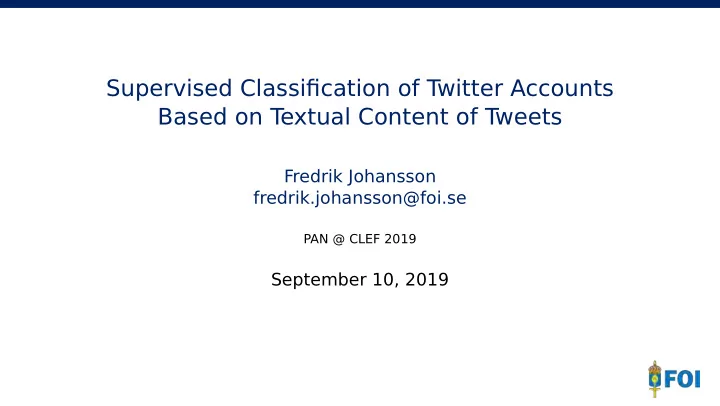

Supervised Classification of T witter Accounts Based on T extual Content of T weets Fredrik Johansson fredrik.johansson@foi.se PAN @ CLEF 2019 September 10, 2019
Outline - A security and intelligence perspective on bot and gender profiling - Motivation and examples - Our previous work (mostly metadata-based) - Implemented two-step binary classification approach - Features and classifiers - Results
Information operations in social media Social media used by e.g. state actors to carry out various types of information operations - Bots: "Drown" hashtags with unrelated content, information spread (trending topics), manipulate reputation statistics . . . - Trolls: increase tension and polarization in societies (NATO, migration, Brexit, gun control, etc.) - Hi-jacked accounts: make use of existing accounts’ social network and reputation to reach out to large audience (e.g., hi-jacking of @AP)
Detection of T witter bots - Divert attention from protests by flooding hashtags: e.g., Syria, Mexico, Russia - Amplification of messages: e.g., accounts depicting Hong Kong protesters as violent criminals - Growing threat with improved neural models for text generation, such as GPT-2 and Grover - Increased automation of troll activities?
T ools for analyzing information operations on T witter - Visual analytics for identifying coordinated accounts - NLP object patterns for detecting tweets of interest - E.g., "Lavrov and Putin propaganda machine are on overdrive today" - Automatic classification of bots - E.g., inter-tweet content similarity, inter-tweet timing distributions, inter-tweet delay regularities, # hashtags, # mentions, # URLs
Gender profiling In criminal investigations or intelligence work, profiling anonymous accounts can sometimes be of importance - Example: Death threats sent to politicians to their home adresses (with related searches conducted from a certain IP address) - Profiling gender or other characteristics can sometimes decrease number of likely senders - Use of function words, POS tags etc. - Does not seem to work very well for T witter data!
High-level approach - T wo-step binary classification 1. Bot or human? 2. Male or female? (only if classified as human) - Calculate aggregate statistics based on all tweets from account of interest - Signs of bots which are not visible on individual tweet level - E.g. inter-tweet similarity
Aggregate "metadata" statistics (bot classification) Calculate m , mn , g , std for the following features: Damerau-Levenshtein used as edit distance metric on adjacent tweets.
Content features (bot classification) Aim at simplicity/generalizability rather than optimizing dev-set performance - Concatenate all tweets for current user - Apply TfidfVectorizer in scikit-learn - analyzer = "word", lowercase = True - ngram_range = (1,2), max_features = 800 - min_df = 4, binary = True (TF-part 0 or 1) - use_idf = True, smooth_idf = True - LSTMs or Transformers with pre-trained word embeddings would be more powerful, avoided due to TIRA performance and need for scaling to large datasets in our tools
Bot classifer Trained separate classifiers for TF-IDF and the "metadata" features, due to relative sparseness of TF-IDF vector 1. Logistic regression classifier on the TF-IDF features - Regularization: C=1.0 2. Add output class probabiilties from log. reg. as additional feature 3. Random Forest classifier on statistical features + log. reg. output - n_estimators=500 - max_features="auto" - min_samples_leaf = 1 Grid search was used on training set to select classifiers with suitable parameter settings
Gender classifer Ended up with extremely simple gender classifier - Logistic regression classifier on based on most common TF-IDF features in training data - Regularization: C=1.0 - TF-IDF - analyzer = "word", lowercase = True - ngram_range = (1,1), max_features = 300 - min_df = 10, binary = False - use_idf = True, smooth_idf = True - Experimented with the statistical features, POS tags etc. but did not increase performance
Results Rnk ∗ Task Lang Dev set TIRA testset2 Bots profiling en 0.948 0.960 T op-1 Bots profiling es 0.892 0.882 T op-15 Gender profiling en 0.752 0.838 T op-5 Gender profiling es 0.648 0.728 T op-20 * 55 participating teams in total Consistently underperform on Spanish compared to English. Used default string tokenizer in scikit-learn, probably a terrible idea...
Questions? Thanks for listening! fredrik.johansson@foi.se
Recommend
More recommend